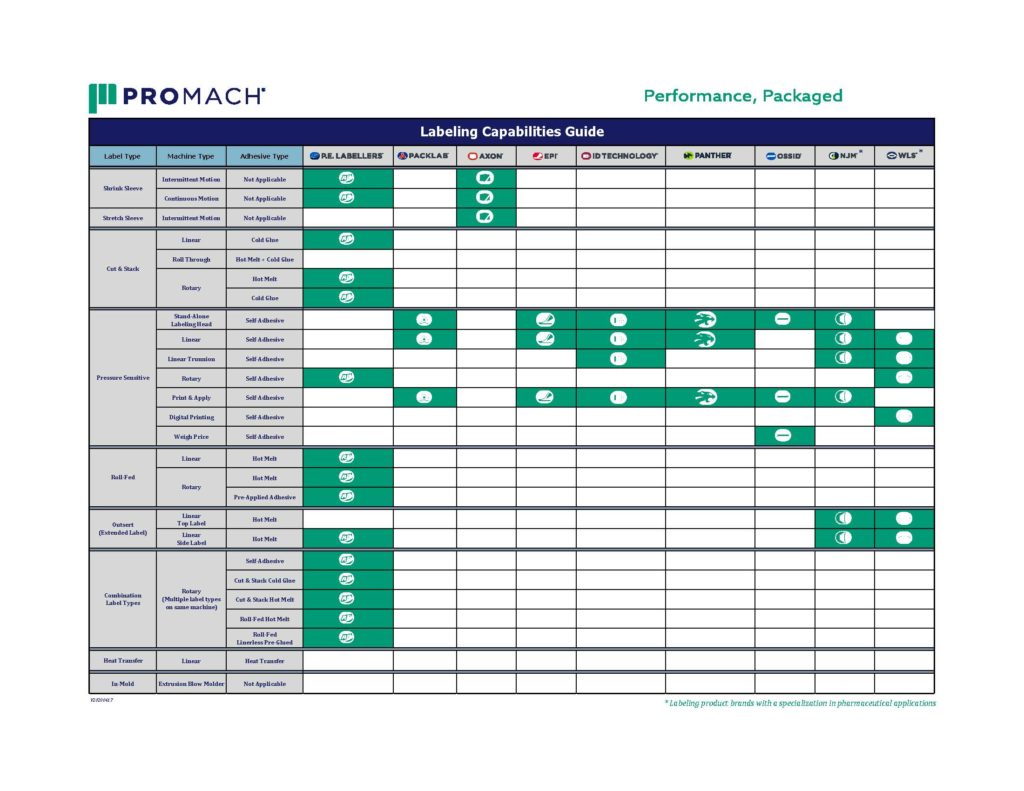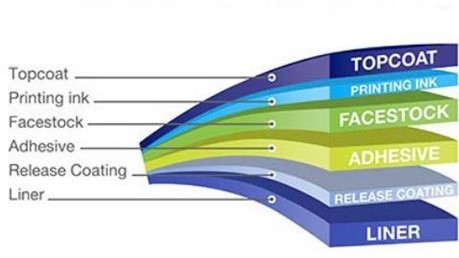
Labels are one of the most important aspects of the packaging industry. Labels are essential because not only do they provide information, but they showcase a brand and help it move across the supply chain. An effective label will creatively highlight what the product is, provide necessary information for the consumer, and will stand out from other products on the shelf. A label should fit the product, fit the package on which it is adhered to, and be able to withstand the rigors of the packing and shipping process.
There are questions one should ask when considering the correct type of label for the product, as there are a range of variables. Questions such as:
- What is being labeled? For instance, what is the size, shape, and material of the product?
- How many labels will be applied to the product? To the case? To the pallet?
- Where is the label being placed on the product? On the case? On the pallet?
- Where is the labeling machine going on the production line?
- What is the product environment, such as, is there moisture or residue on the surface of the application?
- What is the temperature and climate where the label is being applied?
- Are there any regulatory requirements that each label must follow?
- Are there shipping guidelines or requirements that the case or pallet must follow?
Once these questions have been answered, the next step is to determine the correct type of machinery to label the primary and secondary packaging. ProMach has multiple product brands that offer labeling machines to meet a wide range of needs. Chances are, if you have a container, package, case, tray, or pallet, a ProMach product brand can label it. To show just how broad the ProMach labeling equipment portfolio is, we’ve created a labeling matrix of our comprehensive capabilities from each of our product brands. Due to the extent of available solutions, with each having its ideal use case scenarios, we will be featuring a series of blog posts highlighting these labeling capabilities to ultimately help as a guide to those in need. The first type of labeler we will be highlighting is the most prominent and popular on the market – pressure sensitive.
Pressure sensitive labels, also known as self-adhesive labels, are one of the most popular labels because the adhesive material allows for a label to be pressure applied to almost every kind of glass, plastic, paper, or corrugated packaging surface. The label itself is made of five layers: the liner, release coat, adhesive, facestock, and topcoat. There are options to choose from for these layers, such as paper or film for liner, paper, film or foil for the facestock, and topcoat material which can come in gloss, UV coating, or laminates. Adhesives also come in a variety of different options which can be chosen depending on the requirements of the label, such as permanent, removable, cold temperature-resistant, or water soluble. The methods of applying pressure sensitive labels include direct transfer (roll-on or wipe-on), tamp application, and air-jet (air-applied, air-blow, etc.). Because of all these specifications and variations in label and application, it is important to take into account the size, material, and shape of what is being labeled, what speed is needed to apply the label, and what length of time the label adhesive will be needed to stick to determine the exact machine that will adhere the label to the product.
ProMach product brands offer various types of pressure sensitive labeling machines: stand-alone labeling heads, linear and linear trunnion labelers, rotary labelers, print and apply labelers, weigh price labelers, as well as digital printing. Which is chosen is based on necessary labeling requirements for the product and its desired output.
A pressure sensitive stand-alone labeling head is a budget friendly, versatile labeler that can be a stand-alone feature or can be integrated into a complete packaging system. Typically, labeling heads are mounted on a portable stand, enabling them to move quickly and easily from one location to another as needed to maximize productivity. These labelers have vertical and horizontal capabilities and can still run labels at wide range of speeds. These labelers are a great option for production lines with space concerns, start-up companies, or production lines that already have efficient product handling.
Pressure sensitive linear (or inline) labeling systems are broadly used across the packaging line and consist of two main features, a conveyor that moves the product in one direction and one or more labeling heads. They may also incorporate a feature to effectively stabilize products as they are labeled while moving on the conveyor, such as feedscrew and trunnion roll systems, spacing wheels or belts, and aligning belts or chains. Linear labelers are effective at achieving lower speed targeted production goals compared to rotary labeling systems and are the most commonly used system for basic labeling needs. Linear labeling systems label items such as bottles, jars, or vials in primary packaging, as well as sealed trays, cases, and other packages in secondary packaging. Because the design of the system is less complex and typically does not run as fast (with a few situational exceptions), when compared to rotary labeling systems, linear systems are generally often less expensive, easier to maintain (with less change-parts), and have a smaller footprint.
As mentioned above, linear labelers can be a competitive alternative to rotary for high-speed labeling applications in certain situations. For instance, high-speed linear labelers have more upside when handling small, round containers such as pharmaceutical vials. Because containers have the potential to be spaced closer together with linear labelers (when using a feedscrew or trunnion), in comparison to a rotary machine, similar output is achievable with smaller containers while going at overall lower machine speeds.
Pressure sensitive rotary labeling systems are the most robust option especially when it comes to decorative label applications in primary packaging. They are generally the way to go for products with demanding or complex labeling specifications. If the product needs orienting, multiple labels, and/or requires fast speeds to meet high output, the rotary labeler is the machine for the job. In a rotary labeler system, bottles enter a star wheel and are transported on a continuously rotating carousel where the product is turned on bottle plates and labeled at different position points. These machines can run at high-speed rates, some in the range of 600-800 packages per minute (ppm) depending on the situation, with servo motors aiding in the orientation process. Rotary labelers can be equipped with up to eight different labeling stations and can apply labels at different positions such as spot, neck, belly, back, and top. Consequently, these machines are often much larger than linear machines and have a more substantial footprint within a packaging line.
Pressure sensitive weigh price labelers are an attractive option for flexible, accurate, and simple labeling for high-speed continuous motion weight labeling of items such as meat and cheese, as well as other price-by-weight primary packaging items. These machines are modular and can be easily upgraded to fully automatic equipment, offering flexible machinery for production. These labelers can come in a variety of sizes, which can be used for grocery retailers in the meat or bakery departments or can be included in a robust packaging line.
Pressure sensitive digital printing, also called print on demand, is a compact stand-alone system for primary packaging that offers flexibility and control, designed specifically for demanding print requirements. Full labels are printed entirely on demand from blank label rollstock in full color or simple black and white in desired quantities at time of need, omitting changeovers for limited runs and excess storage for numerous SKUs. For companies who have multiple products to label, multiple label configurations, multiple languages and more, digital printing can simplify logistics and offer quick turnaround time for printing.
Pressure sensitive print and apply labelers are best used for secondary packaging, such as cases, trays, stretch-wrapped pallets, etc. The labels are printed from a roll as the product is labeled which allows for variable information such as time specific applications, bar codes, and shipping information to be changed or swapped easily. Print and apply labels typically do not include any branding and are usually standard black and white. Print and apply labelers have a higher speed capability to keep up with more secondary packaging situations.
Pressure sensitive labeling machines are chosen for many major packaging lines because it’s an efficient way to label a product. These labels can be simply created with many custom designs of colors and shapes, making them perfect to display branding, information, and nutritional facts on standard or irregular shapes, from small to large sizes. There are many different materials a pressure sensitive machine can apply labels to across many industries, including processed food products, beverages, fresh produce, nutraceuticals, personal care, pet food, household, red meat, poultry packaging, and more. You’ll see pressure sensitive labels on plastic and glass bottles, jars, clam shells, and other packaging in all retail settings. Look around at any grocery or convenience store and you will see many labels that have been printed and applied with a pressure sensitive label. You’ll also find pressure sensitive labelers tailored specifically for the pharmaceutical industry, which require government regulations, and ProMach product brands NJM and Weiler Labeling Systems specialize in labeling these specific products such as vials, syringes, bottles, and more.
ProMach product brands have labeling equipment options for most pressure sensitive needs. P.E. Labellers, PackLab, ID Technology, EPI, Ossid and pharmaceutical product brands NJM and WLS, each have a labeling application that can outfit a need for pressure sensitive applications, as shown in the graph above. Depending on the specific requirements when labeling a product, any of these ProMach product brands can assist in creating the perfect labeled product.


